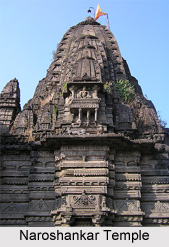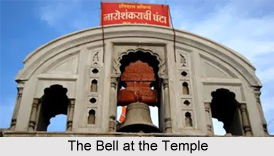 Naroshankar Temple is one of the ancient and famous holy shrines nestled at Nashik in the Indian state of Maharashtra. It is situated in the Panchavati area on the banks of the river Godavari. The temple is built in the honour of Lord Sankara who is fondly called as `anga` by the Nasikites. It has a giant bell which has historical significance. The temple was constructed in 1747 by Naroshankar Rajebahaddur in a unique style of architecture. The architectural style of the temple is called "Maya" style. Every year, art and history lovers from various distant places flock to this temple to witness its majestic architecture.
Naroshankar Temple is one of the ancient and famous holy shrines nestled at Nashik in the Indian state of Maharashtra. It is situated in the Panchavati area on the banks of the river Godavari. The temple is built in the honour of Lord Sankara who is fondly called as `anga` by the Nasikites. It has a giant bell which has historical significance. The temple was constructed in 1747 by Naroshankar Rajebahaddur in a unique style of architecture. The architectural style of the temple is called "Maya" style. Every year, art and history lovers from various distant places flock to this temple to witness its majestic architecture.
Architecture of Naroshankar Temple
It is one of the most poignantly made temple architecture of the 18th century. The main temple is erected on a platform. Compared to the inside, the outer carvings and decorations of Naroshankar Temple are quite stunning. It has rows of eye-catching designs. One layer represents decorative lacework; the other is that of peacocks holding beaded garlands. There are statues of saints in Padmasana, in four directions- one holding rosary, other a holy book, they are all scholars. Some of the statues are in a dilapidated state, their hands are broken. An assembly of animals is also visible-tigers, monkeys, elephants etc.
 Naroshankar Bell at Naroshankar Temple
Naroshankar Bell at Naroshankar Temple
The Naroshankar Temple is surrounded by 11 feet fortification. The four corners have umbrellas, called `Meghadambari` or `Barasati`. The Godavari floods washed one of them away, only three remain today. The fortification includes a `Bell House` in the front part. The acclaimed bell, called "Naroshankar Bell" is fixed there; it represents the victory memorial over the Portuguese. The Maratha ruler Bajirao Peshwa`s younger brother Chimaji Appa won the Fort of Vasai against the Portuguese in war. The famous king of Peshwas, Mr. Naroshankar Rajebahadur played a critical role in this context. After winning the fort, Vasai Portuguese Church Bell was removed, marched atop an elephant till Nasik with great pomp and vigour, and offered to Naroshankar as a medal, an award for bravery. The bell is made of bronze, six feet in diameter; the year engraved on it is 1921. It is said that the resounding ring of the bell can be heard from over 5 miles. The Municipal Corporation of Nasik has taken up recent renovations of the bell.





















